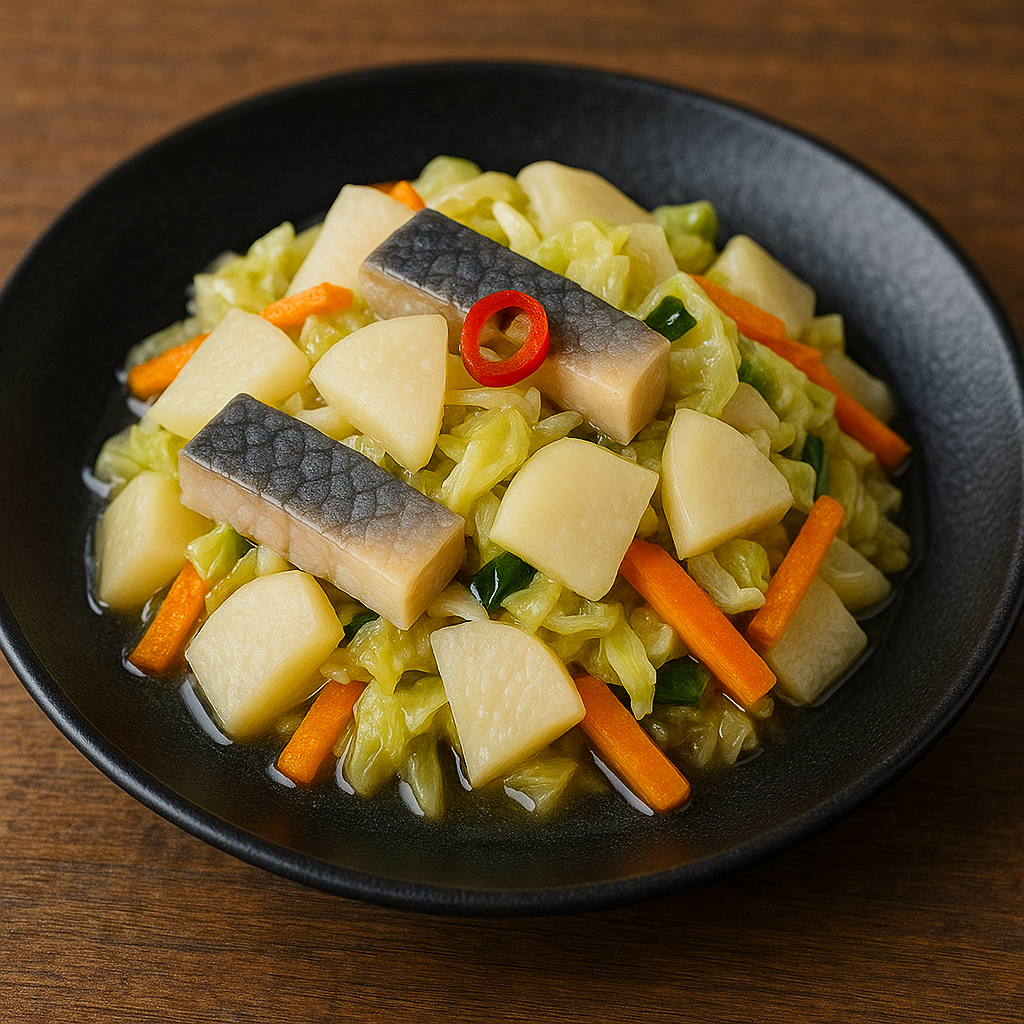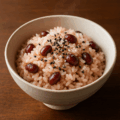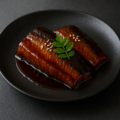ニシン漬けの特徴
北海道の冬の保存食
ニシン漬けは、北海道を代表する冬の発酵保存食で、塩漬けにした身欠きニシンと白菜や大根、人参を一緒に漬け込み、乳酸発酵させた郷土料理です。
魚と野菜の旨味の融合
発酵により、ニシンの旨味と野菜の甘みが合わさり、独特の風味と酸味が楽しめます。冬の寒さを利用した自然発酵ならではの味わいです。
家庭から伝わる伝統の味
家庭ごとに漬け方や配合が異なり、代々受け継がれてきた冬の保存食として親しまれています。
ニシン漬けのレシピ
材料(4人分)
- 身欠きニシン … 200g(塩抜きしたもの)
- 白菜 … 1/2株
- 大根 … 1/2本
- 人参 … 1本
- 米麹 … 100g
- 唐辛子 … 2本
- 塩 … 適量
作り方
- 身欠きニシンは水で戻し、適当な大きさに切る。
- 白菜・大根・人参は食べやすい大きさに切り、塩を振って下漬けし、水気を絞る。
- 漬物容器に野菜、ニシン、米麹、唐辛子を交互に重ね入れる。
- 重石をして冷暗所で1〜2週間発酵させる。
- 酸味と旨味が程よく出たら完成。
シェフのワンポイントアドバイス
発酵が進みすぎると酸味が強くなるため、食べ頃を見極めましょう。米麹を加えることで甘みと旨味が引き立ちます。
ニシン漬けの栄養価(1人分の目安)
- エネルギー:約80〜120 kcal
- たんぱく質:5〜8 g(ニシン由来)
- 脂質:3〜5 g
- 炭水化物:10〜15 g(野菜・米麹由来)
- 食物繊維(野菜由来)
- 乳酸菌(発酵由来)
- ビタミンB群・D(ニシン由来)
発酵食品として腸内環境を整える効果が期待でき、魚と野菜の栄養も同時に摂れる健康的な料理です。
ニシン漬けの歴史
漁師町の保存食
ニシンの漁が盛んだった北海道で、冬の保存食として作られたのが始まりです。
発酵文化との融合
野菜と魚を一緒に漬け込み、寒冷な気候を利用して乳酸発酵させるという、北海道ならではの発酵文化として発展しました。
郷土料理としての定着
現在では家庭料理としてだけでなく、地域の特産品や土産物としても広まり、北海道を代表する冬の味覚のひとつとなっています。
English Version
Features of Nishin-zuke
A Traditional Winter Preserved Food of Hokkaido
Nishin-zuke is a traditional fermented preserved dish from Hokkaido, made by pickling salted dried herring (migaki-nishin) together with vegetables such as napa cabbage, daikon, and carrots. It is a representative winter dish of the region.
Harmony of Fish and Vegetables
Through fermentation, the umami of herring blends with the sweetness of vegetables, creating a unique flavor with a pleasant tang. The cold winter climate contributes to the natural fermentation process, giving it a distinctive taste.
A Home-style Tradition
Each household has its own way of preparing Nishin-zuke, with different ratios and methods, making it a cherished winter preserved food passed down through generations.
Recipe
Ingredients (for 4 servings)
- Dried herring (migaki-nishin, desalted) … 200 g
- Napa cabbage … 1/2 head
- Daikon radish … 1/2
- Carrot … 1
- Rice malt (kome-koji) … 100 g
- Red chili peppers … 2
- Salt … as needed
Instructions
- Rehydrate the dried herring in water and cut into bite-sized pieces.
- Cut the napa cabbage, daikon, and carrot into pieces, sprinkle with salt, and lightly pickle them. Squeeze out the excess water.
- In a pickling container, layer the vegetables, herring, rice malt, and chili peppers alternately.
- Place a weight on top and leave in a cool, dark place for 1–2 weeks to ferment.
- When the sourness and umami reach the desired balance, it is ready to eat.
Chef’s Tip
If fermentation progresses too far, the flavor can become overly sour, so check the taste as it matures. Adding rice malt enhances sweetness and depth of flavor.
Nutritional Value (per serving, approx.)
- Calories: 80–120 kcal
- Protein: 5–8 g (from herring)
- Fat: 3–5 g
- Carbohydrates: 10–15 g (from vegetables and rice malt)
- Dietary fiber (from vegetables)
- Lactic acid bacteria (from fermentation)
- B vitamins and vitamin D (from herring)
As a fermented food, Nishin-zuke supports digestive health while providing nutrients from both fish and vegetables, making it a wholesome winter dish.
Historical Background
A Fishermen’s Preserved Food
Nishin-zuke originated in Hokkaido’s fishing villages, where abundant herring catches were preserved for the harsh winter months.
Integration with Fermentation Culture
The method of fermenting fish and vegetables together developed as part of Hokkaido’s unique fermentation culture, utilizing the region’s cold climate.
Established as a Regional Cuisine
Today, Nishin-zuke is enjoyed not only as a homemade dish but also as a regional specialty and souvenir, recognized as one of Hokkaido’s representative winter delicacies.



何でも質問してください!